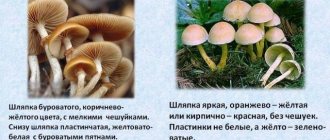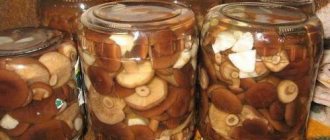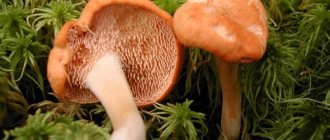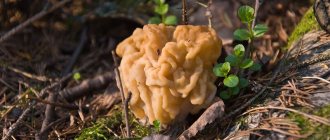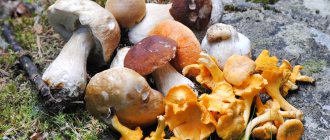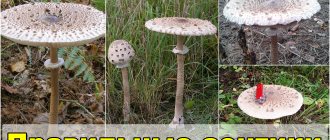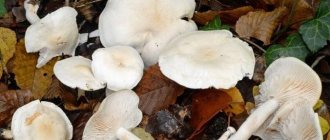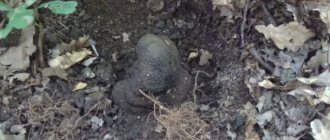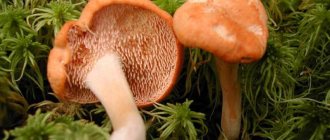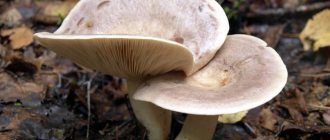Mushroom loading (photo)
In the photo, the Podgruzdok mushroom
grows in coniferous forests, especially under pine trees, on sandy soil.
Fruits from July to October. Found singly or in small groups.
The black loader has no doubles. See what the loader looks like in the photo and read the description about it below in the article:
These mushrooms can be found in almost all forests of Russia: both coniferous and deciduous. They usually grow in groups, which mushroom pickers really like. They hide under the leaves, so you need to look for them and dig them out.
Among its edible qualities, the mushroom is also popular for its medicinal properties. It is actively used in pharmacology for the manufacture of various medications, as well as in folk medicine.
Podgrudok belongs to the Russula family. Found in forests from June to November. They come in several types:
- white;
- black;
- blackening;
- often plastic.
The appearance of the load is similar to that of a milk mushroom. The similarities are visible in the shape of the cap. But it does not have fringed edges, is matte white or with spots of a brownish tint, and is dry. Its size is no more than 20 cm in diameter. The fashion of the mushroom is distinguished by the presence of a dent on the cap at the top, and the adult one has funnels. The pulp is brittle. The plates of this type of mushroom are often white, sometimes they can have a bluish tint.
Let's take a closer look at all the types of loading presented, see photos later in the article.
Fantasy of Nature
Bloody Tooth Mushroom - a forest pie with blood.
Nature is a great artist and sculptor, creating outlandish forms and images. The imagination of this amazing creator is fully manifested in the world of mushrooms, an excellent example of which is the wonderful Hydnellum Peckii Hydnellum Peckii , better known as the Bloody Tooth Mushroom.
This amazing creation of natural genius has such a characteristic appearance that it can only be confused with his closest relatives. This mushroom belongs to the genus Hydnellum, family Bunkeraceae, and is considered inedible due to its extremely bitter taste.
White load (dry load)
In the photo Podgruzdok is white
The white podgruzdok (dry milk mushroom) has a short and thick stem. It is white in color. The older the mushroom, the more likely it is that the stem will be hollow in the middle.
The russula mushroom has a cap with a diameter of 7 to 20 cm, a pure white shade, and dry. Often has attached lumps of earth or leaves. The plates are white and thin. Their shade can be blue or slightly greenish. The pulp is dense, white. Does not change color when scrapped. The plates are white, caustic.
Edible rows
These include:
- Matsutake;
- Mayskaya;
- Gray;
- Greenfinch;
- Lilac-footed;
- Earthy;
- Scaly;
- Gigantic;
- Crowded.
Matsutake (Tricholoma matsutake)
Synonyms:
- shod;
- Japanese truffle;
- pine mushroom.
| Head | Creamy brown, silky with large dark scales and light beige plates. Flat, thickened in the center, cracks with growth. The edges are torn. |
| Leg | with scales, white at the cap with a transition to cinnamon color towards the ground. Under the cap there is a film ring. |
| Smell | Bright, pine with a hint of cinnamon |
| Pulp | Beige or milky |
| Where does it grow? | In the pine forests of the Urals, Siberia, and the Far East. |
May row (Calocybe gambosa)
Synonyms:
- May mushroom;
- Kalocybe May;
- St. George's mushroom.
One of the most coveted trophies of the spring “mushroom-free” season. Appears on the 20th of May, and in the sun - even at the end of April. Grows until the last ten days of June.
| Head | Hump-shaped, then half-prostrate, silky, milky in color. Older specimens have diluted ocher with white plates. |
| Leg | Cylindrical, medium thickness, slightly yellowing |
| Smell | Pleasant, freshly ground flour |
| Pulp | White, strong texture, fleshy, without darkening or turning sour when cooked. |
They are easy to distinguish by their unpleasant smell and time of appearance (late August - early October)
Gray (Tricholoma portentosum)
Synonyms:
- streaked;
- serushka;
- green grass;
- gray sandpiper.
One of the best mushrooms of late autumn. Approved for sale at official agricultural markets.
| Head | Widely bell-shaped with a drooping edge and white plates; in mature ones, it is flat with a thickening in the center, with a wavy edge and greenish or grayish-white plates. The skin is smooth, slippery, with radial dark gray streaks. Color - gray or gray-brown, in the center - black, towards the edge - light gray. |
| Leg | smooth, columnar, less often club-shaped, turning yellow when pressed. |
| Smell | Slightly mealy. |
| Pulp | Soft, white, grayish. |
She has:
- gray narrow cone-shaped head;
- more dark strokes on the cap, no lightening towards the edge.
Greenfinch (Tricholoma equestre, flavovirens)
Synonyms for this row:
- Green;
- Knight's;
- Golden;
- Lemon;
- Zelenka;
- Jaundice.
| Head | Initially convex, with the edge turned down. When ripe, it is flat-spread with a hump in the center and a wavy edge. The skin is shiny, with small radial fibers; in the center they gather into scales. The surface and plates range from lemon yellow to olive or rusty brown. |
| Leg | Cylindrical, with longitudinal fibers of light beige color. |
| Smell | Strong smell of fresh dough. |
| Pulp | White, pale yellow, does not change color when cooked. The taste is soft, mealy. |
For information! This mushroom has an inedible counterpart - the spruce row (Tricholoma aestuans). It is distinguished from the edible greenfinch:
- smell (unpleasant);
- the shape of the cap (bell-shaped, without an obvious tubercle);
- thin long hollow leg;
- less fleshy cap.
In the pale grebe it has:
- "Skirt" at the hat;
- Thickening at the root;
- The remains of the cover at the butt, i.e. grows as if from a cup.
Lilac-legged (Lepista personata, Lepista saeva)
Synonyms:
- Bluefoot;
- Blue root;
- Bicolor;
- Lepista lilac.
| Head | cup-shaped, fleshy, yellowish with a rolled-up lavender edge. The plates are beige. |
| Leg | Thick, strong, light purple or with purple streaks. |
| Smell | Pleasant and delicate fruit aroma. |
| Pulp | White, pale lilac when cut. |
Frequent plate loading
In the photo, Frequently plate loading
Another name for this species is common nigella. It is found more often in the south of Russia, in coniferous, mixed or deciduous forests.
The cap is distinguished by a more grayish, sometimes brown tint, which becomes olive and sometimes brown in color as the fungus grows. Its diameter is rarely more than 12 cm. Young mushrooms have a sticky cap, but with age it becomes dry. The leg is the same shade as the cap.
When scrapped, the pulp turns red, then brown, and then turns black. This mushroom has light plates that do not reach its stem.
The taste is inexpressive, the smell is weak.
In medicine, an extract from a frequent-plate loading is used. It has antimicrobial activity. To relax muscles, the properties of this type of mushroom are used in medicine.
In the kitchen, loaded plates are often fried, made into broths, marinated and salted. The mushroom does not need to be pre-boiled.
Names
Human imagination is also very sophisticated, especially when it comes to such a bright and unusual creation of nature. That’s why Gidnellum Peck has plenty of funny names:
- The official scientific name is given in honor of the American mycologist Charles Horton Peck, one of the leading American mushroom specialists in the nineteenth century.
- The creepy name “Bloody Tooth” is explained by the fact that, with age, pointed growths appear along the edges of the cap, and the mushroom can really look like a bloody tooth.
- The English name of this mushroom is “Devil's Tooth Bleeding Fungus”, that is, “Bleeding Tooth of the Devil”, which is echoed by one of the Russian-language names “Devil's Hedgehog”. The Prince of Darkness, once again, was dragged in for no reason.
- In addition to names that naturally inspire disgust, there are, on the contrary, those that emphasize the attractive and appetizing appearance of this mushroom, for example, “Strawberry and Cream.” Indeed, it seems so.
- There is another “food version” of the name “Danish Cookies with Strawberry Jam”.
Bloody Tooth Mushroom – forest pie with blood
Podgrudok blackening: photo and description
In the photo Podgruzdok is turning black
The blackening mushroom has a cap up to 20 cm. As it grows, it changes its shade from whitish brown, and in the old mushroom it becomes black. The plates are white, sometimes yellowish, but as they grow older they also become dark. They are quite rarely located from each other.
The flesh of the body is hard, quite dense, and when reacting with air changes its color to dark. The mushroom tastes pleasant, not hot. The leg of the black species is solid and acquires a brown tint.
Look at this loading mushroom in the photo:
Peculiarities
Fungi of the lamellar family belong to the group of higher basidiomycetes. Their peculiarity is the lamellar hymenophore. The spore-bearing layer is a growth on the underside of the cap. They can be thin and frequently spaced or wide and sparse. They come in different colors.
The plates diverge from the base of the stem to the edges of the cap. In different species they either grow tightly together with the stem, or pass onto it, or are located only on the cap. Sometimes there are jumpers between the plates.
The hat can be of any shape: cone-shaped, spread-out, cushion-shaped. It usually changes as it grows. The peculiarity of the leg is that it is most often hollow. Less often, empty areas are combined with dense ones. The stalk consists of thin hyphae - hard fibers.
Another feature of this family is a fragile fruiting body with brittle pulp. It is annual, can be fleshy or leathery, and sometimes releases milky juice when broken. Species that do not have sap quickly dry out in the sun.
Black podgrudok mushroom
Loader is black in the photo
The pulp turns black when cut
The black podgrudok differs from the blackening one mainly only in the shade of the pulp on the cut. It turns red. Its taste and other qualities remain similar.
In pharmacy it is used as an antioxidant and antisarcoma agent. Nigrikacin is obtained from it.
The mushroom is used for food in fried, salted or pickled form. It is also suitable for making soups.
Podgrudok, a description of the species of which we have provided you with, are quite frequent guests in the forests of our territory. They grow under foliage or needles and reveal their presence only by small tubercles above the ground. Mushroom pickers love these mushrooms for their taste.
- Author: Tatyana
Rate this article:
- 5
- 4
- 3
- 2
- 1
(10 votes, average: 5.6 out of 5)
Share with your friends!
Collection rules
The basic rule of “quiet” hunting is not to take a mushroom that is in doubt. But inexperienced mushroom pickers often neglect it, which is why there are so many poisonings during the season. To avoid unpleasant consequences, you need to learn to distinguish between edible and poisonous agaric mushrooms. There are several rules for collecting them that it is advisable to remember for those who love “quiet” hunting.
- You need to pick mushrooms only in forests and meadows away from the city, industrial enterprises and roads. Toxic substances accumulate in them, so you can even get poisoned by an edible mushroom.
- You should not take very large, overripe, wormy or damaged fruits.
- You need to cut the fruit with the stem, this makes it easier to recognize the characteristic signs of edible and poisonous species.
- It is better to put it in a basket; in a bag the fruits quickly break and spoil. Before putting it down, examine it carefully and clear it of any debris.
- For the lamellar family, the method of recognizing poisonous species by smell is not suitable. Some varieties may smell nice but will be inedible.
- The collected fruits should be prepared on the same day; it is better not to store them.
You must also remember that mushrooms are a healthy food, but difficult to digest. They are not recommended for use by children under 6 years of age, as well as by people with diseases of the gastrointestinal tract.
Lamellar mushrooms are the most common and popular group. Among them there are both valuable and tasty fruits and deadly poisonous ones. You need to learn to distinguish between them, this will help you enjoy delicious mushroom dishes and avoid poisoning.
Row poisoning
Despite the fact that among the poisonous rows there are no deadly ones, it is quite possible to be poisoned by them.
The causes of poisoning may be:
- consumption of poisonous mushrooms;
- incorrect method of preparing conditionally edible rows;
- picking mushrooms near roads, in city parks, near industrial enterprises with hazardous production. Rowing plants very actively accumulate salts of heavy metals from the atmosphere and soil, which is extremely dangerous for humans.
Symptoms
Signs of poisoning will begin to appear between 30 minutes and 2 hours after the mushrooms have been eaten.
There are:
- excessive salivation;
- cold sweat;
- weakness;
- nausea;
- heaviness in the stomach;
- uncontrollable vomiting;
- diarrhea.
The rows do not cause respiratory depression, confusion, or serious damage to internal organs, so the victim may well begin actions to save himself. And the sooner he does this, the faster he will recover.
And of course, call an ambulance as quickly as possible.
First aid
First of all, you need to remove toxins that have entered the stomach before they are absorbed into the blood.
For this:
- drink as much water as possible, preferably salted (1 tsp per liter of water) or a slightly pink solution of potassium permanganate;
- induce vomiting by pressing on the root of the tongue;
- then take any adsorbent - activated carbon, Filtrum, Smecta.
When poisoning occurs, dehydration occurs, so the victim must be given plenty of fluids.
To keep the degree of poisoning to a minimum and the recovery process to proceed faster, make it a rule:
- Never eat large portions of new mushrooms.
- Do not mix new mushrooms with already known ones.
- Save small pieces of new mushrooms to determine their toxicity.
